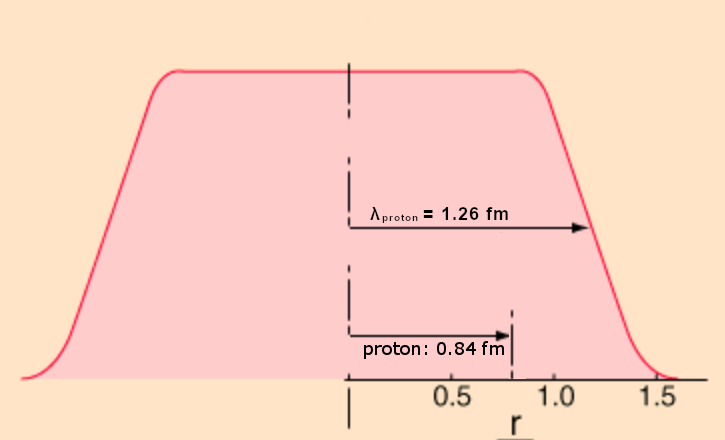We want to digress for a moment to pick up something important that we glossed over earlier. You will remember our discussion about the measured size of the Hydrogen nucleus, which only contains a proton:

We want to explain the symbol we used for the average measured size, which we called λproton. It turns out this measured size is actually the wavelength of the proton. Let us explain what we mean by this and why it is so important.
Up until the end of the 19th century, physicists had a lot of success treating light as waves, much like the waves travel in water. In the early 1900’s, measurements in some experiments started to indicate that light actually came in packets, called photons. Physicists came to realize that other particles, like electrons, also sometimes seemed to act like waves.
Well, which is it? Is light a wave or a particle? Is an electron a particle or a wave? The answer seemed to depend on how it was observed. If you were looking for a wave, you found a wave. If you were looking for a particle, you got a particle. This led to a model which came to be called Quantum Mechanics. According to this model, an electron could become either a particle or a wave, and it didn’t decide which it was until you looked at it! Before being observed it was in a state where it had some probability of being a wave, and another probability of being a particle. The decision was made at the time it was observed.
For the past 100 years this model has been in some ways very successful, but in other ways a disaster. It gives rise to philosophical problems which remain unresolved. For one thing, it is still unclear the extent to which this model reflects reality:
…there is very little agreement, among physicists and among philosophers, about what the world is like according to quantum mechanics.
https://plato.stanford.edu/entries/qm/
For a physicist, this is not a good statement to make about a model of the physical universe, especially after 100 years of trying to make sense of it all.
The New Physics removes much of the motivation for the highly problematic, probabilistic roots of Quantum Mechanics. The reason is this: its simple hypothesis that when a particle is created it displaces the space that used to be where the particle now resides, causing the surrounding space to be compressed (and then measured as the edge of the nucleus.) And the radius of this compressed space is precisely the wavelength of the particle created! This means the particle and the wave are created at exactly the same time and always exist together. No wonder you sometimes measure a particle, and other times a wave, depending on your measurement apparatus. But it isn’t deciding to be one or the other with some probability: it is always both.
In recent years, clever experiments have been devised which have observed the same phenomenon as being both a particle and a wave, substantiating The New Physics model and putting physics on a firmer intellectual foundation than the century-old shaky footing of Quantum Mechanics.